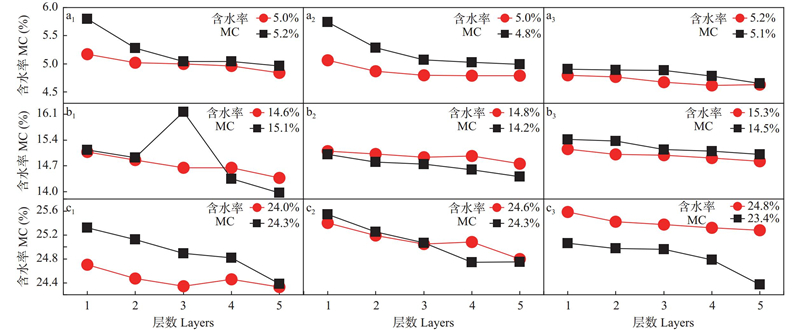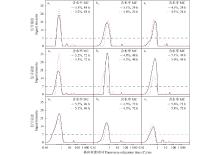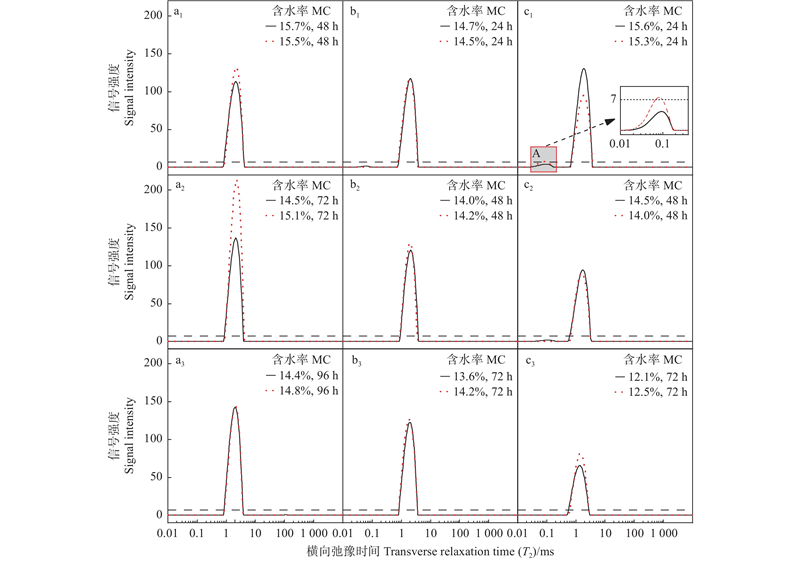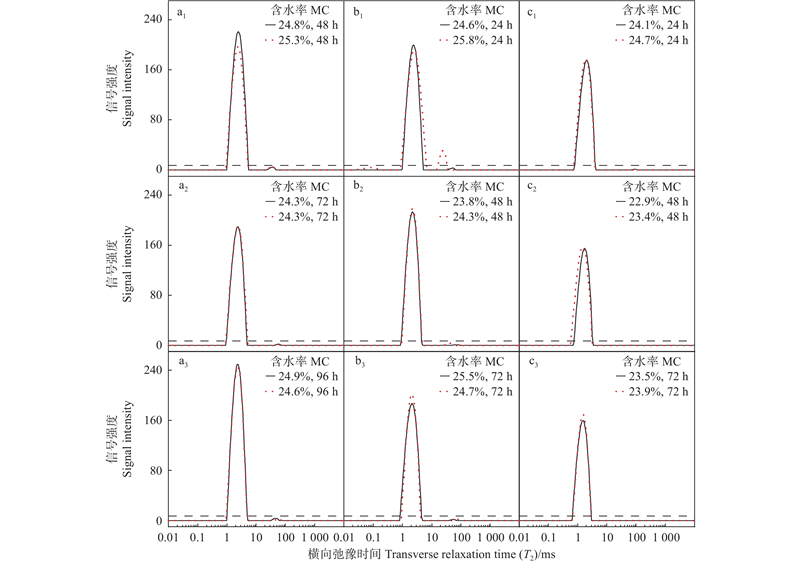

林业科学 ›› 2025, Vol. 61 ›› Issue (10): 38-48.doi: 10.11707/j.1001-7488.LYKX20240493
• 前沿热点 • 上一篇
收稿日期:2024-08-19
出版日期:2025-10-25
发布日期:2025-11-05
通讯作者:
施静波
E-mail:shijb@njfu.edu.cn
基金资助:
Luxiao Qian1,Xin Gao2,Jianxiong Lü1,Youming Dong1,Jingbo Shi1,*( )
)
Received:2024-08-19
Online:2025-10-25
Published:2025-11-05
Contact:
Jingbo Shi
E-mail:shijb@njfu.edu.cn
摘要:
目的: 针对常用饱和盐溶液法和饱水干燥法等木材含水率调控方法存在平衡时间长、调控精度差等难以满足核磁共振技术测试需求的问题,提出一种新的适用于木材核磁共振研究的含水率调控新方法——加水平衡法,以缩短调控时间、提高调控精度。方法: 采用加水平衡法调控杨木试样至目标含水率5%、15%和25%。加水后,平衡工艺设定为:平衡温度为45 ℃,平衡时间为48、72和96 h;平衡温度为60和75 ℃,平衡时间为24、48和72 h。对试样沿加水方向含水率梯度及由低场核磁共振试验所得横向弛豫时间图谱进行分析,优化平衡温度和平衡时间。结果: 45、60和75 ℃平衡温度下,平衡时间对样品实际含水率偏差和标准差无明显影响。相似目标含水率条件下,加水平衡法所得样品实际含水率偏差总体上小于饱和盐溶液法相应数值。目标含水率为5%和15%时,试样在45 ℃下平衡72 h或在60 ℃下平衡48 h后,其内部含水率梯度基本趋于稳定;目标含水率为25%时,该临界工艺条件为45 ℃下平衡72 h 或60 ℃下平衡24 h。室温下二次平衡工艺可进一步减小试样内部含水率梯度,使其趋近准平衡态。目标含水率为15%、平衡温度为75 ℃、平衡时间为24 h以及目标含水率为25%、平衡温度为60 ℃、平衡时间为24 h工艺条件下获得的试样横向弛豫时间图谱中存在多个峰,其余工艺条件下图谱中仅存在单一吸着水峰。综合试样含水率梯度及核磁图谱结果获得加水平衡法的最优工艺为:45 ℃下平衡72 h 或60 ℃下平衡48 h。结论: 相较于传统方法,加水平衡法的效率和所得实际含水率精度更高,为木材核磁共振表征中的含水率调控提供了新途径。
中图分类号:
钱露潇,高鑫,吕建雄,董友明,施静波. 块状木材含水率调控新方法——加水平衡法工艺优化[J]. 林业科学, 2025, 61(10): 38-48.
Luxiao Qian,Xin Gao,Jianxiong Lü,Youming Dong,Jingbo Shi. A New Approach for Conditioning Solid Wood Samples: Optimization of Water-Addition-Equilibrium Method[J]. Scientia Silvae Sinicae, 2025, 61(10): 38-48.
表4
加水平衡法与饱和盐溶液法实际平衡时间"
| 平衡方法 Conditioning method | 平衡条件 Equilibrium condition | 平衡时间 Equilibrium time/d |
| 加水平衡法 Water-addition- equilibrium method | 45 ℃ | 3 |
| 60 ℃ | 2 | |
| 75 ℃ | 2 | |
| 饱和盐溶液法 Saturated salt solution method | 25 ℃, KCl饱和溶液 25 ℃, KCl saturated salt solution | 20 |
| 25 ℃, MgCl2饱和溶液 25 ℃, MgCl2 saturated salt solution | 20 | |
| 25 ℃, 蒸馏水 25 ℃, distilled water | 25 |

图3
目标含水率5%、15%、25%时杨木试样分层含水率 平衡温度分别为45 ℃(a1、b1、c1)、60 ℃(a2、b2、c2)、75 ℃(a3、b3、c3),黑色和红色曲线分别代表一次和二次平衡工艺,样品实际平均含水率标注在图中。The equilibrium temperatures of 45 ℃ (a1, b1, c1), 60 ℃ (a2, b2, c2), 75 ℃ (a3, b3, c3). The back and red curves represent the one-step and two-step equilibrium processes, respectively. The actual average MC of samples are shown in the figures."


图5
目标含水率5%时杨木试样$ {T}_{2} $图谱 平衡温度分别为45 ℃(a1、a2、a3)、60 ℃(b1、b2、b3)、75 ℃(c1、c2、c3),试样的实际含水率和平衡时间均标注在图中,图中黑色虚线表示信号强度为7的临界值。The equilibrium temperatures were 45 ℃ (a1, a2, and a3), 60 ℃ (b1, b2, and b3), and 75 ℃ (c1, c2, and c3). The actual MC and equilibrium time of the specimens are shown in the figures, where the black dashed line represents a signal strength of 7."


图6
目标含水率15%时杨木试样$ {T}_{2} $图谱 平衡温度分别为45 ℃(a1、a2、a3)、60 ℃(b1、b2、b3)、75 ℃(c1、c2、c3),试样的实际含水率和平衡时间均标注在图中,图中黑色虚线表示信号强度为7的临界值. The equilibrium temperatures were 45 ℃ (a1, a2, and a3), 60 ℃ (b1, b2, and b3), and 75 ℃ (c1, c2, and c3). The actual MC and equilibrium time of the specimens are shown in the figures, where the black dashed line represent a signal strength of 7."


图7
目标含水率25%时杨木试样$ {T}_{2} $图谱 平衡温度分别为45 ℃(a1、a2、a3)、60 ℃(b1、b2、b3)、75 ℃(c1、c2、c3),试样的实际含水率和平衡时间均标注在图中,图中黑色虚线表示信号强度为7的临界值。The equilibrium temperatures were 45 ℃ (a1, a2, and a3), 60 ℃ (b1, b2, and b3), and 75 ℃ (c1, c2, and c3), and the actual MC and equilibrium time of the specimens are shown in the figures, where the black dashed line represent a signal strength of 7."

表5
不同平衡工艺条件下杨木试样吸着水峰$ {T}_{2} $总结及相应F-检验结果①"
| 目标含水率 Target moisture content (%) | 平衡温度 Equilibrium temperature (Te)/℃ | 平衡时间 Equilibrium time (τe)/h | 吸着水峰T2 T2 values of bound water/ms | 单个温度水平检验 Single temperature level test | 整体检验 The overall test | |||
| F | P | F | P | |||||
| 5 | 45 | 48 | 0.5±0.0 | 0.584 | 0.611 | 1.396 | 0.314 | |
| 72 | 0.46±0.04 | |||||||
| 96 | 0.43±0.08 | |||||||
| 60 | 24 | 0.55±0.08 | 0.779 | 0.534 | ||||
| 48 | 0.4±0.2 | |||||||
| 72 | 0.47±0.07 | |||||||
| 75 | 24 | 0.4±0.1 | 2.109 | 0.268 | ||||
| 48 | 0. 4±0.1 | |||||||
| 72 | 0.26±0.06 | |||||||
| 15 | 45 | 48 | 2.2±0.1 | 1.302 | 0.392 | 8.583 | 0.057 | |
| 72 | 2.2±0.1 | |||||||
| 96 | 2.0±0.1 | |||||||
| 60 | 24 | 2.0±0.1 | 1.302 | 0.392 | ||||
| 48 | 2.0±0.1 | |||||||
| 72 | 1.9±0.1 | |||||||
| 75a | 24 | 1.7±0.2 | 5.409 | 0.081 | ||||
| 48 | 1.65±0.08 | |||||||
| 72 | 1.4±0.1 | |||||||
| 25 | 45 | 48 | 2.4±0.0 | 4.510 | 0.065 | 0.088 | 0.918 | |
| 72 | 2.5±0.1 | |||||||
| 96 | 2.2±0.3 | |||||||
| 60a | 24 | 2.3±0.3 | 1.333 | 0.312 | ||||
| 48 | 2.25±0.00 | |||||||
| 72 | 2.17±0.09 | |||||||
| 75 | 24 | 2.03±0.08 | 0.337 | 0.799 | ||||
| 48 | 1.5±0.2 | |||||||
| 72 | 1.54±0.06 | |||||||
| 董海胜, 刘恒言, 徐 楠, 等. 基于低场核磁共振的预包装即食牛肉保质期预测模型研究. 食品工业科技, 2024, 45 (8): 301- 308. | |
| Dong H S, Liu H Y, Xu N, et al. Research on shelf life predicting model of prepackaged instant beef based on low-field nuclear magnetic resonance. Science and Technology of Food Industry, 2024, 45 (8): 301- 308. | |
| 高建民, 王喜明. 2018. 木材干燥学. 2版. 北京: 科学出版社. | |
| Gao J M, Wang X M. 2018. Wood drying. 2nd edition. Beijing: Science Press. [in Chinese] | |
|
高玉磊, 李新宇, 雷 鹏, 等. 利用TD-NMR技术研究杨木高温干燥过程水分分布. 波谱学杂志, 2016, 33 (3): 479- 490.
doi: 10.11938/cjmr20160313 |
|
|
Gao Y L, Li X Y, Lei P, et al. Water distribution in poplar during high-temperature drying process studied by time-domain nuclear magnetic resonance. Chinese Journal of Magnetic Resonance, 2016, 33 (3): 479- 490.
doi: 10.11938/cjmr20160313 |
|
| 高玉磊, 徐 康, 蒋佳荔, 等. 2018. 时域核磁共振技术在木材科学研究领域的应用. 世界林业研究, 31(5): 33−38. | |
| Gao Y L, Xu K, Jiang J L, et al. 2028. Application of time domain nuclear magnetic resonance technology to wood science research. World Forestry Research, 31(5): 33−38. [in Chinese] | |
| 李 婷. 2021. 基于PAMAM介导生物素化纳米探针的LF-NMR快速检测沙门氏菌. 南昌: 南昌大学. | |
| Li T. 2021. Rapid detection of Salmonella by LF-NMR based on PAMAM-mediated functionalized nanoparticle probe. Nanchang: Nanchang University. [in Chinese] | |
|
马大燕, 王喜明, 张明辉. 核磁共振研究木材吸着过程中水分吸附机理. 波谱学杂志, 2011, 28 (1): 135- 141.
doi: 10.3969/j.issn.1000-4556.2011.01.014 |
|
|
Ma D Y, Wang X M, Zhang M H. Mechanism of water sorption during adsorption process of wood studied by NMR. Chinese Journal of Magnetic Resonance, 2011, 28 (1): 135- 141.
doi: 10.3969/j.issn.1000-4556.2011.01.014 |
|
|
马尔妮, 王 望, 李 想, 等. 基于LFNMR的木材干燥过程中水分状态变化. 林业科学, 2017, 53 (6): 111- 117.
doi: 10.11707/j.1001-7488.20170613 |
|
|
Ma E N, Wang W, Li X, et al. The states of water in wood during drying process studied by low-field nuclear magnetic resonance (LFNMR). Scientia Silvae Sinicae, 2017, 53 (6): 111- 117.
doi: 10.11707/j.1001-7488.20170613 |
|
| 屈兰兰, 吴 月, 何 珊. 低场核磁共振技术在肉制品加工工艺中的应用. 农产品加工, 2024, (7): 88- 91. | |
| Qu L L, Wu Y, He S. Application of low field nuclear magnetic resonance technology in meat processing. Farm Products Processing, 2024, (7): 88- 91. | |
| 田虎楠. 2022. 煤系页岩瓦斯吸附-解吸特性核磁共振谱定量表征. 阜新: 辽宁工程技术大学. | |
| Tian H N. 2022. Quantitative characterization of gas adsorption and desorption characteristics of coal shale by nuclear magnetic resonance spectroscopy. Fuxin: Liaoning Technical University. [in Chinese] | |
| 王喜明. 2007. 木材干燥学. 3版. 北京: 中国林业出版社. | |
| Wang X M. 2007. Wood drying. 3rd edition. Beijing: China Forestry Publishing House. [in Chinese] | |
| 王立双. 2018. 基于近红外光谱的木材干缩湿胀研究. 北京: 北京林业大学. | |
| Wang S L. 2018. Study on hygroexpansion of wood based on near-infrared spectroscopy. Beijing: Beijing Forestry University. [in Chinese] | |
|
肖乾隆, 李 锦, 李 伍. 姚桥矿7号煤层垂向孔隙结构及分形特征研究. 中国煤炭地质, 2023, 35 (9): 1- 13, 26.
doi: 10.3969/j.issn.1674-1803.2023.09.01 |
|
|
Xiao Q L, Li J, Li W. Study on vertical pore structure and fractal characteristics of No. 7 coal seam in Yaoqiao coal mine. Coal Geology of China, 2023, 35 (9): 1- 13, 26.
doi: 10.3969/j.issn.1674-1803.2023.09.01 |
|
| 闫 越. 2015. 利用单边核磁共振研究木材的分层吸湿性. 呼和浩特: 内蒙古农业大学. | |
| Yan Y. 2015. The performance of moisture adsorption profiles in wood evaluated by NMR-MOUSE. Hohhot: Inner Mongolia Agricultural University. [in Chinese] | |
| 臧春龙, 王 坤, 付建新. 低场核磁共振技术在充填体材料的应用优势. 当代化工研究, 2024, (2): 73- 75. | |
| Zang C L, Wang K, Fu J X. Application status of low-field NMR in cementitious and mine filling materials. Modern Chemical Research, 2024, (2): 73- 75. | |
| 张 宇, 赵亚楠, 赵健翔, 等. 基于不同维度低场核磁共振技术的大豆含油率检测与判别. 农业工程学报, 2024, 40 (4): 337- 344. | |
| Zhang Y, Zhao Y N, Zhao J X, et al. Soybean oil content detection and discrimination based on different dimensional low-field nuclear magnetic resonance techniques. Transactions of the Chinese Society of Agricultural Engineering, 2024, 40 (4): 337- 344. | |
| 张黎阳. 2020. 餐厨垃圾厌氧消化后沼渣的好氧堆肥优化研究. 杭州: 浙江大学. | |
| Zhang L Y. 2020. Study on optimization of compost of food waste anaerobic digestion residue. Hangzhou: Zhejiang University. [in Chinese] | |
| 张明辉, 李新宇, 周云洁, 等. 利用时域核磁共振研究木材干燥过程水分状态变化. 林业科学, 2014, 50 (12): 109- 113. | |
| Zhang M H, Li X Y, Zhou Y J, et al. Water status change in wood drying studied by time-domain NMR. Scientia Silvae Sinicae, 2014, 50 (12): 109- 113. | |
| 张亚军. 2023. 基于低场核磁共振技术的生物膜污染形成与演化研究. 长春: 吉林大学. | |
| Zhang Y J. 2023. Research on the formation and evolution of biofilm contamination based on low-field magnetic resonance technology (LF-NMR). Changchun: Jilin University. [in Chinese] | |
| 赵芝弘. 2022. 基于质子探针的木材水分和孔隙的关系研究. 呼和浩特: 内蒙古农业大学. | |
| Zhao Z H. 2022. Study on the relationship between moisture and pore size in wood with proton probe. Hohhot: Inner Mongolia Agricultural University. [in Chinese] | |
|
朱晓风, 赵芝弘, 谭 蕊, 等. 利用单边核磁共振研究樟子松木材干燥水分迁移规律. 波谱学杂志, 2024, 41 (2): 173- 183.
doi: 10.11938/cjmr20233083 |
|
|
Zhu X F, Zhao Z H, Tan R, et al. Water migration characteristics of Pinus sylvestris during the drying process studied by single-sided nuclear magnetic resonance. Chinese Journal of Magnetic Resonance, 2024, 41 (2): 173- 183.
doi: 10.11938/cjmr20233083 |
|
|
Almeida G, Gagné S, Hernández R E. A NMR study of water distribution in hardwoods at several equilibrium moisture contents. Wood Science and Technology, 2007, 41 (4): 293- 307.
doi: 10.1007/s00226-006-0116-3 |
|
|
Arai C, Hosaka S, Murase K, et al. Measurements of the relative humidity of saturated aqueous salt solutions. Journal of Chemical Engineering of Japan, 1976, 9 (4): 328- 330.
doi: 10.1252/jcej.9.328 |
|
|
Araujo C D, Avramidis S, MacKay A L. Behaviour of solid wood and bound water as a function of moisture content. A proton magnetic resonance study. Holzforschung, 1994, 48 (1): 69- 74.
doi: 10.1515/hfsg.1994.48.1.69 |
|
| Araujo C D, MacKay A L, Hailey J R T, et al. Proton magnetic resonance techniques for characterization of water in wood: application to white spruce. Wood Science and Technology, 1992, 26 (2): 101- 113. | |
|
Beck G, Thybring E E, Thygesen L G, et al. Characterization of moisture in acetylated and propionylated radiata pine using low-field nuclear magnetic resonance (LFNMR) relaxometry. Holzforschung, 2018, 72 (3): 225- 233.
doi: 10.1515/hf-2017-0072 |
|
| Bovey F A, Mirau P A, Gutowsky H S. 1988. Nuclear magnetic resonance spectroscopy. Elsevier. | |
|
Cao S Y, Shi J B, Dong Y M, et al. Phase transition behavior of water in original, heat-treated and acetylated poplar woods. Industrial Crops and Products, 2024, 208, 117899.
doi: 10.1016/j.indcrop.2023.117899 |
|
|
Carr H Y, Purcell E M. Effects of diffusion on free precession in nuclear magnetic resonance experiments. Physical Review, 1954, 94 (3): 630- 638.
doi: 10.1103/PhysRev.94.630 |
|
| Cox J, McDonald P J, Gardiner B A. A study of water exchange in wood by means of 2D NMR relaxation correlation and exchange. Holzforschung, 2010, 64 (2): 259- 266. | |
| Flibotte S, Menon R S, MacKay A L, et al. Proton magnetic resonance of western red cedar. Wood and Fiber Science, 1990, 22, 362- 376. | |
| Gao X, Zhuang S Z, Jin J W, et al. Bound water content and pore size distribution in swollen cell walls determined by NMR technology. BioResources, 2015, 10 (4): 8208- 8224. | |
| Ge X, Zhao J, Zhang F, et al. 2019 A practical method to compensate for the effect of echo spacing on the shale NMR T2 spectrum. Earth and Space Science, 6(8): 1489−1497. | |
|
Hartley I D, Kamke F A, Peemoeller H. Absolute moisture content determination of aspen wood below the fiber saturation point using pulsed NMR. Holzforschung, 1994, 48 (6): 474- 479.
doi: 10.1515/hfsg.1994.48.6.474 |
|
|
Labbé N, De Jéso B, Lartigue J C, et al. Moisture content and extractive materials in maritime pine wood by low field 1H NMR. Holzforschung, 2002, 56 (1): 25- 31.
doi: 10.1515/HF.2002.005 |
|
| Lamason C, MacMillan B, Balcom B, et al. Water content measurement in black spruce and aspen sapwood with benchtop and portable magnetic resonance devices. Wood Material Science & Engineering, 2015, 10 (1): 86- 93. | |
|
Li J Y, Ma E N. 2D time-domain nuclear magnetic resonance (2D TD-NMR) characterization of cell wall water of Fagus sylvatica and Pinus taeda L. Cellulose, 2022, 29 (16): 8491- 8508.
doi: 10.1007/s10570-022-04789-y |
|
| MacMillan M B, Schneider M H, Sharp A R, et al. Magnetic resonance imaging of water concentration in low moisture content wood. Wood and Fiber Science, 2002, 34 (2): 276- 286. | |
| Mao Z P, Yu H, Wang Y F, et al. States of water and pore size distribution of cotton fibers with different moisture ratios. Industrial & Engineering Chemistry Research, 2014, 53 (21): 8927- 8934. | |
|
Meiboom S, Gill D. Modified spin-echo method for measuring nuclear relaxation times. Review of Scientific Instruments, 1958, 29 (8): 688- 691.
doi: 10.1063/1.1716296 |
|
|
Menon R S, MacKay A L, Hailey J R T, et al. An NMR determination of the physiological water distribution in wood during drying. Journal of Applied Polymer Science, 1987, 33 (4): 1141- 1155.
doi: 10.1002/app.1987.070330408 |
|
|
Nakamura K, Hatakeyama T, Hatakeyama H. Studies on bound water of cellulose by differential scanning calorimetry. Textile Research Journal, 1981, 51 (9): 607- 613.
doi: 10.1177/004051758105100909 |
|
|
Shi J B, Qian L X, Wang Z S, et al. An alternative approach for conditioning wood samples in nuclear magnetic resonance studies. Wood Science and Technology, 2024, 58 (4): 1409- 1425.
doi: 10.1007/s00226-024-01576-9 |
|
|
Wexler A, Hasegawa S. Relative humidity-temperature relationships of some saturated salt solutions in the temperature range 0 to 50 ℃. Journal of Research of the National Bureau of Standards, 1954, 53 (1): 19- 26.
doi: 10.6028/jres.053.003 |
|
|
Xu K, Lu J X, Gao Y L, et al. Determination of moisture content and moisture content profiles in wood during drying by low-field nuclear magnetic resonance. Drying Technology, 2017, 35 (15): 1909- 1918.
doi: 10.1080/07373937.2017.1291519 |
|
|
Xu K, Yuan S F, Gao Y L, et al. Characterization of moisture states and transport in MUF resin-impregnated poplar wood using low field nuclear magnetic resonance. Drying Technology, 2021, 39 (6): 791- 802.
doi: 10.1080/07373937.2020.1719503 |
| [1] | 陈佳星,付宗营,张永跃,王喜明,卢芸. 基于木材与水分相互作用的木基水凝胶研究进展[J]. 林业科学, 2025, 61(5): 1-11. |
| [2] | 祝亚,伍希志,黄渊硕. 基于局部自相关函数熵的木材砂光表面粗糙度视觉检测方法[J]. 林业科学, 2025, 61(5): 199-206. |
| [3] | 郭娟,焦立超,何拓,马灵玉,姜笑梅,殷亚方. 木材定量解剖研究新进展[J]. 林业科学, 2025, 61(2): 204-218. |
| [4] | 陈炎,孟素戎,黄安民,苏莹莹,孙柏玲. 三聚氰胺-尿素-乙二醛树脂浸渍改性对人工林红锥木材物理力学性能的影响[J]. 林业科学, 2025, 61(1): 166-175. |
| [5] | 朱铭玮,赵薇,付威,高云鹏,王文武,解志军,李淑娴. 国槐种子成熟过程及其水分时空变化[J]. 林业科学, 2024, 60(9): 41-49. |
| [6] | 韩刘杨,郭娟,韩向娜,席光兰,田兴玲,李仁,陈家宝,殷亚方. 饱水考古木材保存状况评估研究进展[J]. 林业科学, 2024, 60(9): 183-198. |
| [7] | 袁鸣,朱铭玮,解志军,康真,李淑娴. 沼生栎种子失水过程中水分时空迁移规律[J]. 林业科学, 2024, 60(6): 44-49. |
| [8] | 杨春梅,刘彤彬,马亚强,丁禹程,王金聪,胡松,宋文龙. 基于响应曲面法的木材喷涂漆雾扩散角度与均匀度优化[J]. 林业科学, 2024, 60(6): 136-147. |
| [9] | 刘守佳,何拓,陆杨,焦立超,郭娟,Alex CWiedenhoeft,殷亚方. 桃花心木木材定量解剖特征变异性及其识别[J]. 林业科学, 2024, 60(5): 169-176. |
| [10] | 杭宇杰,陈志成,王林,牛保亮,刘松松,于博,王晓,刘世荣. 宝天曼8种阔叶树木材密度的解剖学决定因素及其与叶性状的协同与权衡[J]. 林业科学, 2024, 60(4): 62-70. |
| [11] | 唐继新,潘启龙,刘衡,田祖为,陈东成,黄德卫,莫世宇,蒋志林. 红锥人工林立木生长应变的变异规律及受生长弱化处理的影响[J]. 林业科学, 2024, 60(12): 120-127. |
| [12] | 王正,张栋,邹红艳,陈清平,宋利明,张一凡. 动态测试木材泊松比的悬臂梁1/3跨贴片法[J]. 林业科学, 2024, 60(12): 128-135. |
| [13] | 潘玺,李康,杨忠. 基于卷积神经网络的近红外光谱与数字图像特征信息融合木材树种识别[J]. 林业科学, 2024, 60(12): 136-145. |
| [14] | 刘美宏,闫琦铭,訾龙博,雷亚芳,闫丽. 糠醇-环氧植物油复合改性毛白杨木材的物理力学性能[J]. 林业科学, 2024, 60(11): 149-159. |
| [15] | 田智康,葛浙东,郑焕祺,郑志帅,周玉成. 基于深度学习的75种阔叶材微观辨识方法[J]. 林业科学, 2024, 60(10): 94-103. |
| 阅读次数 | ||||||
|
全文 |
|
|||||
|
摘要 |
|
|||||